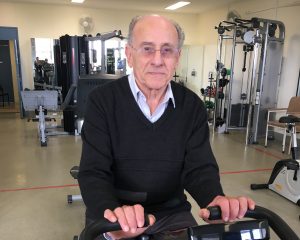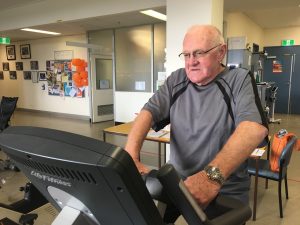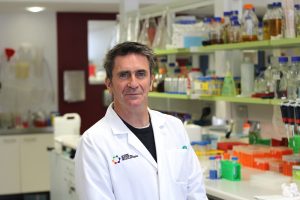September is global Pulmonary Fibrosis Awareness Month.
We’re pioneering a novel treatment for IPF called AD-114, and we’re proud to be working alongside global experts in the field.
To raise awareness of IPF throughout September, we’re shining a spotlight on the following local heroes carrying out globally recognised work to better understand and treat IPF, and sharing patient stories, as told in their own words.
Bill Van Nierop – Lung Foundation Australia Supporter and IPF Patient
Max Tabbaa – Idiopathic Pulmonary Fibrosis Patient
Anne Holland – Professor of Physiotherapy, La Trobe University and Alfred Health
Stan Holden – Pulmonary Fibrosis Patient
Associate Professor Mick Foley – AdAlta Chief Scientific Officer
Glen Westall – Specialist Respiratory and Transplant Physician
About IPF
Idiopathic pulmonary fibrosis (IPF) is a rare fibrotic lung condition that causes persistent and progressive scarring of the tiny air sacs (alveoli) in the lungs, with symptoms including shortness of breath and coughing[1]. Lung Foundation Australia estimate that there are around 2,300 new cases diagnosed in in Australia every year[2]. The prognosis of IPF is very poor, with a median survival of only three to five years after diagnosis.[3]
There are just two treatments on the market and the disease continues to progress in the majority of patients despite treatment.[4]
“We have a mantra that IPF will impact our lives, but it will not impact how we live our lives.” – Bill Van Nierop, 64, Redland Bay

I was originally diagnosed with potential IPF in March 2015, when some indicators were noticed on an X-Ray and a subsequent CT scan I’d had to ensure a bout of pneumonia had cleared up.
I had an inkling that something might be amiss when my GP’s surgery called the day of my CT scan to say my doctor wanted to see me ASAP, and they had made an appointment for 8.40am next morning. I thought: They don’t usually do that to advise all is okay!!
In my case, confirmation of the likely presence of early stage IPF was a little scarier initially, as my older sister had been through what was then called Interstitial Lung Disorder, which I’m guessing is very similar. This meant I was aware of disease progression and potential outcome. It was not confirmed immediately and I was fortunate to have a very proactive GP who arranged an appointment with a lung physician.
At this point, my reaction was more about “well, maybe I don’t”, as I had no noticeable symptoms to my mind. Oh, there was the change in my ability to swim a reasonable distance without getting breathless, which I had put down to just age. I was 62, after all. After a few interesting weeks and an open lung biopsy, my lung physician confirmed the presence of early stage IPF. I guess I wasn’t overly surprised. I’d noticed the ‘clubbing’ of some of my nails sitting in a motel room in Dubbo the week previous, and a quick trip to ‘Dr Google’ confirmed this as a possible symptom. The confirmed diagnosis did still take the wind out of my sails.
Being ‘idiopathic’ in nature, there is no clear cause. Like many baby boomers, I did smoke for 10 years, giving up in 1981. In fact the lung biopsy showed no evidence of smoking, and there is virtually nothing in my background that ‘leaps’ out as a contributing cause. Whilst my sister has something very similar, I’m reliably informed that in my case it is extremely unlikely to be genetic.
After diagnosis I set about learning all I could about the disease, in terms of progression, impact of exercise, diet, potential treatments and of course my lifestyle and ability to carry on a ‘normal’ working life. Lung Foundation Australia (LFA) are an incredible organisation in terms of support, information and creating awareness of IPF. I am currently an advocate and volunteer for LFA.
I had an exercise regime based on walking prior to diagnosis, but anecdotal evidence suggested exercise with available treatments had certainly had benefits for a number of IPF sufferers around the world. As a result, I increased walking daily to at least 90 minutes and swimming for much of the year.
Living with IPF is impacted by available treatments, and I was placed on a trial medication within months, which has slowed progress of the disease but can have significant side effects.
In my role I travel interstate through rural areas, and find fatigue from IPF can be an issue in managing lifestyle, and commitments. My wife and I have a mantra that IPF will impact our lives, but it will not impact how we live our lives. I continue to work, exercise, and we travel both domestically and internationally to do those things we we want to. It just requires a little more planning to manage any potential side effects and fatigue.
There are really only two viable treatments currently available for IPF in Australia, and I believe anywhere in the world. These drugs can slow progression by up to 50%, and in my case of early phase, appear to have worked as intended, and delivered the results to this point. Because of the lack of awareness of lung disease, and the real stigma attached to having a lung disease, available funds for research projects are difficult to access, and this area seems to come at the end of the available funds available from public donations.
As a result of lack of awareness, stigma and lack of available funding, I have tried to have some small impact since diagnosis to assist LFA and others, initiating and supporting some events in the public domain. In 2016, my wife and I completed the Sydney city2surf, raising funds for Lung Foundation Australia and embarking on an awareness campaign through my employer, AGnVET Services, who have a number of rural stores across NSW, Qld and Victoria.
Following some success with this, I initiated my ‘Long Walk for Lungs’ with the support again of AGnVET and Lung Foundation Australia. This event was supported by major suppliers to the agricultural industry as sponsors, and a host of rural community events. Between 14 August, and 1 September, I walked 700kms around central NSW, at an average of 45kms per day, and talking to groups, individuals, selling raffle tickets in pubs and clubs, and providing interviews on Prime TV, and ABC rural programs. In a small way we created awareness of IPF, and lung disease in general, tackled the stigma, and raised just over $100k for Lung Foundation Australia to support a number of initiatives.
IPF is virtually unknown in Australia, patients are often reluctant to talk about it, it is often still misdiagnosed, and many patients are still provided little information about their disease, potential treatments and the importance of lifestyle and exercise in the process. We do not talk about lung disease, we often ‘shame’ those diagnosed, and generally fail to have empathy as we do with other illnesses. This is despite the fact that more Australians lose their battle with IPF each year than with some of the more known, chronic, rare diseases.
I intend to do keep doing my bit to change the way we think about IPF.
“They told me I had five years to live.” – Max Tabbaa, 74, Albert Park

Max went to see a doctor about four years ago because of a chronic cough that both he and his wife were sick of dealing with. After a few x-rays and scans, he was told that he had lung, heart and stomach issues. A lung biopsy undertaken during an angiogram showed that he had IPF.
“They told me I had five years to live,” he said. “I don’t want to be in a nursing home, I want to go straight to palliative care and let me die in peace. When the time comes, when I cannot breathe anymore, let me go.
I would try a new treatment, depending on the side effects and how long it would give you.
I’m on morphine liquid and tablets, and I’m lucky I still don’t need oxygen.
The cough is there all the time. I feel now that I am counting down the days, which is stressful for me and my wife.”
Anne Holland, Professor of Physiotherapy, La Trobe University and Alfred Health

Anne Holland led the first clinical trial of pulmonary rehabilitation for people with idiopathic pulmonary fibrosis (IPF), which had published outcomes in 2008.
Pulmonary rehabilitation is now a recommended treatment for people with IPF, with patients receiving an individually tailored program of exercise and education designed to reduce their symptoms, improve fitness and enhance wellbeing.
“As a physiotherapist working in pulmonary rehabilitation, I could see its benefits for people with other chronic lung diseases, but there were no clinical trials to test whether it worked in IPF,“ Anne said.
“Pulmonary rehabilitation improves how patients feel and function. New drugs have brought hope for people with IPF as they slow the progression of disease, but they don’t improve quality of life, and not all patients are eligible.
“Pulmonary rehabilitation is an important treatment because it makes people with IPF feel better, and the vast majority of patients are eligible to take part.
“People with IPF live with distressing symptoms, particularly breathlessness and cough. Being very tired is another common symptom. Whilst some symptoms are directly related to the lung condition, some are related to the reduction in strength and fitness that occur when someone becomes unwell.
“One of the benefits of pulmonary rehabilitation is that it allows patients to improve their strength and fitness, in a safe environment, under the supervision of experts. People with IPF are often pleasantly surprised about how much exercise they can do by the end of a pulmonary rehabilitation program, and how much better it makes them feel.”
“Treatments that can improve how people with IPF feel and function are urgently needed. It’s great that we now have treatment options for IPF, but more research is needed to come up with better ones. IPF Awareness Month is a great opportunity to talk about that.”
“After they did all their scans, they showed me my lungs, and I didn’t like the look of them.”
– Stan Holden, 75, Port Melbourne

I’ve been short-winded and what have you for a fair while, and I’ve had a few episodes in the hospital lately, over the past six to nine months. After they did all their scans, they showed me my lungs, and I didn’t like the look of them.
There were lots of holes in them and scarring. Some of the scarring was my rheumatism, some probably by asbestos, and that was a bit worrying to me. That was about two months ago.
They asked me to go into this program at The Alfred. I go there twice a week and do exercises, and every week or so they up the exercise. It’s riding bikes and going on the treadmill for about 15 minutes. They take your heart rate before you start and three times during the ride, and then afterwards. Twice a week. But it doesn’t worry me.
I am 75 years old and have been reasonably healthy over the years. As a child I had rheumatic fever and was told it would not affect me later in life, but it has always left me short-winded. I couldn’t keep up with sports. When all the other kids would run around the park, I couldn’t.
I’ve probably got a few bad habits – I smoked since I was about 10 or 11 years of age until I was about 45 or 50. I haven’t smoked for 25 years. They told me the damage was done.
The funny part about it is that I go for a walk every morning with the dog for half an hour and in the afternoon, and it doesn’t seem to worry me, but when I get up of a night to go to the toilet and then lie back down, I’m gasping for air as soon as I lay down.
I did ask them if I would have to have any medical operations or what have you, they told me this will just see me out.
It’s all so new to me. I’m only just learning about it all.
Associate Professor Mick Foley – AdAlta Chief Scientific Officer

Reflecting on the moment in time when he realised the potential for our lead i-body candidate, AD-114, to treat fibrotic conditions such as idiopathic pulmonary fibrosis, AdAlta’s founding scientist Associate Professor Michael Foley said:
“Science is often a slow build up and, while you always have hope, you can never be sure it’s going to work. When we showed that mice given a fibrosis-causing chemical no longer developed fibrosis when also given our AD-114 i-body – that was when I thought that we just might have something after all.”
Associate Prof. Foley is an internationally recognised leader in phage display, the technology used to screen AdAlta’s i-body library to identify new drug candidates, and he’s published over 70 scientific publications.
“I’ve always been fascinated by antibodies and how they can protect us by binding to specific molecules on microbes,” he said.
“Back at around the late 90’s, the scientific community were trying to construct antibodies that could target various diseases, not just infections. So when colleagues and I developed the “i-bodies”, which are small antibodies inspired by the ones found in sharks, I was keen to see if they would work against important diseases like fibrosis.”
The study on the effects of AD-114 on mice with fibrosis was carried out in 2016.
“We believe that AD-114 is going to be a novel approach to lung fibrosis, one that has not been applied by any other company,” Associate Prof Foley said. “We have also shown encouraging results in the laboratory on other fibrotic conditions, for example in the eye and liver.
“But I’m afraid that science is not always as quick as we would like, and since these i-bodies are a new approach there is some more work we have do to do be absolutely sure they are safe and how best to administer them.
“Two drugs, Nintedanib and Pirfenidone are available now and while they are very important, I think it’s fair to say that have limitations, and they don’t work for all patients. However there have been some very encouraging results from phase 2 trials for new agents that target fibrosis. Hopefully soon there will be several options for patients with this disease, including AD-114.”
Associate Professor Glen Westall – Specialist Respiratory and Transplant Physician

Associate Professor Glen Westall has worked in the field of lung fibrosis for more than 15 years, published over 70 original research manuscripts and co-authored 8 book chapters in the field of lung fibrosis and lung transplantation.
Yet despite his extensive knowledge about the disease, Idiopathic Pulmonary Fibrosis (IPF) can still surprise him.
“Medical text books suggest that most diseases behave similarly, however the human experience tells us otherwise,” said Assoc. Prof Westall.
“Some patients with IPF can be stable for decades, whilst others often have a very aggressive disease that deteriorates rapidly.”
A highly regarded specialist based at The Alfred, Assoc. Prof. Westall’s interest in lung fibrosis was sparked more than 15 years ago when he worked in London as a registrar in the Royal Brompton Hospital’s Lung Fibrosis service under two giants in the field, Prof Ron du Bois and Prof Athol Wells.
“Back then, we had no treatments for IPF, we were heavily involved with clinical trials, recognising that without treatment, IPF was a progressive and typically fatal condition.
“We are entering an exciting era for lung fibrosis. We now have two antifibrotic agents, Nintedanib and Perfenidone that are available in Australia. More importantly, there are a large number of phase 1 and phase 2 studies running or in the pipeline evaluating new antifibrotic agents”
“Whilst we are making progress, there remains much work that still needs to be done in understanding IPF, both at a patient and a scientific level.”
[1] Lung Foundation Australia [online] at http://lungfoundation.com.au/health-professionals/idiopathic-pulmonary-fibrosis-registry/ [accessed 3 August 2017]
[2] Lung Foundation Australia [online] at http://lungfoundation.com.au/patient-support/rarelung/idiopathic-pulmonary-fibrosis-ipf/ [accessed 3 August 2017]
[3] ATS, 2000; Raghu et al., 2011
[4] Tzouvelekis A, Bonella F, Spagnolo P, ‘Update on Therapeutic Management of Idiopathic Pulmonary Fibrosis’, Therapeutics and Clinical Risk Management, 2015 Mar 3;11:359-70. doi: 10.2147/TCRM.S69716. eCollection 2015
